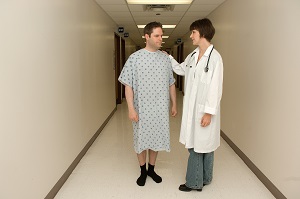
What is Outpatient Total Knee Replacement?
Total knee replacement is the surgical treatment for knee arthritis, where the damaged knee is removed and replaced with an artificial knee implant. Traditionally performed as an inpatient procedure, total knee replacement surgery is now being conducted on an outpatient basis, allowing you to go home on the same day of the surgery.
This is made possible with recent advances such as improved perioperative anesthesia, minimally invasive techniques and initiation of rehabilitation protocols soon after surgery.
When is Outpatient Total Knee Replacement Suggested?
Outpatient total knee replacement is considered when your vital signs are stable, such as heart and respiratory rate, blood pressure, and temperature. Moreover, you need to be able to maintain pain control with oral medication and tolerate a regular diet before being discharged on the same day of surgery.
Outpatient Total Knee Replacement Procedure
The outpatient procedure is performed using advancements in anesthetic techniques like a femoral regional block that produces a centralized anesthetic effect and does not require a hospital stay for its effects to wear off, like traditional general anesthesia.
You will be lying on your back on the operating table and a tourniquet is applied to your upper thigh to reduce blood loss. The arthritic knee is approached through small incisions of three-to-four inches (compared to the eight- to twelve-inch-long incision used in the standard open surgical technique), ensuring that the surrounding muscles and tendons are not cut. This facilitates faster recovery. The damaged portions of the femur (thighbone) are trimmed at appropriate angles using specialized jigs and special guides to ensure a perfect fit of the implant. The next step involves the removal of the damaged area of the tibia (shinbone) and the back of the kneecap.
Custom-implants are created using 3-D modeling from a CT scan. This makes sure that the implant fits securely and requires minimal trimming of the surrounding soft tissues. The femoral component is attached to the end of the femur with bone cement. The tibial component is then secured to the end of the bone using bone cement. Your surgeon places a polyethylene liner that acts as an articular surface between the thighbone, shin implants and the back of the kneecap to ensure smooth gliding movement. With all the components in place, the knee joint is examined for range of motion.
All excess cement is removed and the entire joint is cleaned out with a sterile saline solution to prevent infection. Drains are inserted and the incision is closed. A surgical dressing or bandage is placed. The whole process takes just over an hour.
What to Expect after Outpatient Total Knee Replacement
Several hours after surgery, you will be discharged from the hospital following a thorough examination to make sure you meet the requirements for discharge such as stable vital signs during exercise, ability to eat and take pain medicine by mouth. You generally have a two- to four-week recovery compared to the two-to-three-months needed to recover from traditional knee surgery.
Advantages of Outpatient Total Knee Replacement
The advantages of the outpatient procedure include:
- Minimal surgical dissection
- Shorter recovery period
- Shorter hospital stay
- Reduced postoperative pain
- Less blood loss during surgery
- Increased range of motion after surgery
- Less damage to surrounding tissues
